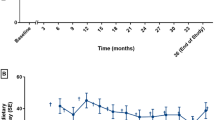Abstract
Sapropterin dihydrochloride (Kuvan®) is a synthetic formulation of the active 6R-isomer of tetrahydrobiopterin, a naturally occurring co-factor for phenylalanine hydroxylase. In the EU, sapropterin is approved for the treatment of hyperphenylalaninemia in patients ≥4 years of age with tetrahydrobiopterin-responsive phenylketonuria (PKU), and in adults and children with tetrahydrobiopterin deficiency who have been shown to be responsive to such treatment. In the US, it is approved to reduce blood phenylalanine levels in patients with hyperphenylalaninemia due to tetrahydrobiopterin-responsive PKU.
Oral sapropterin effectively lowers blood phenylalanine levels in a proportion of patients with PKU; to date, there are no published efficacy trials of the specific sapropterin formulation under review in patients with tetrahydrobiopterin deficiency. Sapropterin was well tolerated in patients with PKU, although longer-term tolerability data are required. Sapropterin is the first non-dietary treatment for patients with PKU that has been shown in randomized, double-blind trials to be effective in lowering blood phenylalanine levels. Thus, sapropterin provides a promising treatment option for patients with PKU who are tetrahydrobiopterin responsive.
Similar content being viewed by others
References
Sanford M, Keating GM. Sapropterin: a review of its use in the treatment of primary hyperphenylalaninaemia. Drugs 2009; 69(4): 461–76
Matalon R, Koch R, Michals-Matalon K, et al. Biopterin responsive phenylalanine hydroxylase deficiency. Genet Med 2004 Jan–Feb; 6(1): 27–32
Erlandsen H, Pey AL, Gámez A, et al. Correction of kinetic and stability defects by tetrahydrobiopterin in phenylketonuria patients with certain phenylalanine hydroxylase mutations. Proc Natl Acad Sci U S A 2004; 101(48): 16903–8
European Medicines Agency. Kuvan®: summary of product characteristics [online]. Available from URL: http://www.emea.europa.eu/humandocs/PDFs/EPAR/kuvan/H-943-PI-en.pdf [Accessed 2009 Jan 18]
US FDA Center for Drug Evaluation and Research. Sapropterin dihydrochloride review [online]. Available from URL: http://www.fda.gov/cder/foi/nda/2007/022181s000_MedR_P1.pdf [Accessed 2008 Aug 1]
Feillet F, Clarke L, Meli C, et al. Pharmacokinetics of sapropterin in patients with phenylketonuria. Clin Pharmacokinet 2008; 47(12): 817–25
US FDA. Sapropterin dihydrochloride: prescribing information [online]. Available from URL: http://www.fda.gov/cder/foi/label/2007/022181lbl.pdf [Accessed 2008 Aug 5]
Burton BK, Grange DK, Milanowski A, et al. The response of patients with phenylketonuria and elevated serum phenylalanine to treatment with oral sapropterin dihydrochloride (6R-tetrahydrobiopterin): a phase II, multicentre, open-label, screening study. J Inherit Metab Dis 2007 Oct; 30(5): 700–7
Levy HL, Milanowski A, Chakrapani A, et al. Efficacy of sapropterin dihydrochloride (tetrahydrobiopterin, 6R-BH4) for reduction of phenylalanine concentration in patients with phenylketonuria: a phase III randomised placebo-controlled study. Lancet 2007 Aug 11; 370(9586): 504–10
Lee P, Treacy EP, Crombez E, et al. Safety and efficacy of 22 weeks of treatment with sapropterin dihydrochloride in patients with phenylketonuria. Am J Med Genet Part A 2008 Nov 15; 146A: 2851–9
Trefz FK, Burton BK, Longo N, et al. Efficacy of sapropterin dihydrochloride in increasing phenylalanine tolerance in children with phenylketonuria: a phase III, randomized, double-blind, placebo-controlled study. J Pediatr. Epub 2009 Mar 2
Author information
Authors and Affiliations
Corresponding author
Additional information
Adapted and reproduced from Drugs 2009; 69 (4): 461-476. The full text article[1] was reviewed by: E. Czeizel, Foundation for the Community Control of Hereditary Diseases, Budapest, Hungary; S.A. Doggrell, Pharmacy Discipline, School of Life Sciences, Queensland University of Technology, Brisbane, Queensland, Australia; M. Giovannini, Department of Pediatrics, San Paolo Hospital, University of Milan, Milan, Italy; V. Leuzzi, Department of Child Neurology and Psychiatry, University of Rome La Sapienza, Rome, Italy; H.L. Levy, Division of Genetics, Children’s Hospital Boston and Harvard Medical School, Boston, Massachusetts, USA; J.J. Mitchell, Department of Medical Genetics, Montreal Children’s Hospital, Montreal, Quebec, Canada; and B. Wilcken, Department of Biochemical Genetics and Newborn Screening, Children’s Hospital at Westmead, Sydney, New South Wales, Australia. The manufacturer of the agent under review was offered an opportunity to comment on the original article during the peer review process. Changes based on any comments received were made on the basis of scientific and editorial merit. The preparation of the original article and this spotlight was not supported by any external funding
Rights and permissions
About this article
Cite this article
Sanford, M., Keating, G.M. Spotlight on Sapropterin in Primary Hyperphenylalaninemia. BioDrugs 23, 201–202 (2009). https://doi.org/10.2165/00063030-200923030-00007
Published:
Issue Date:
DOI: https://doi.org/10.2165/00063030-200923030-00007




